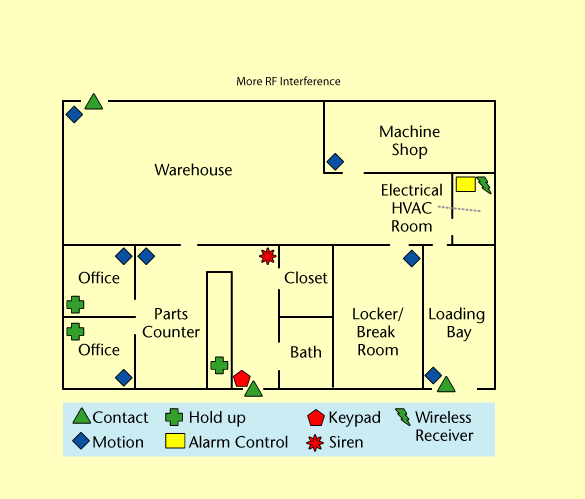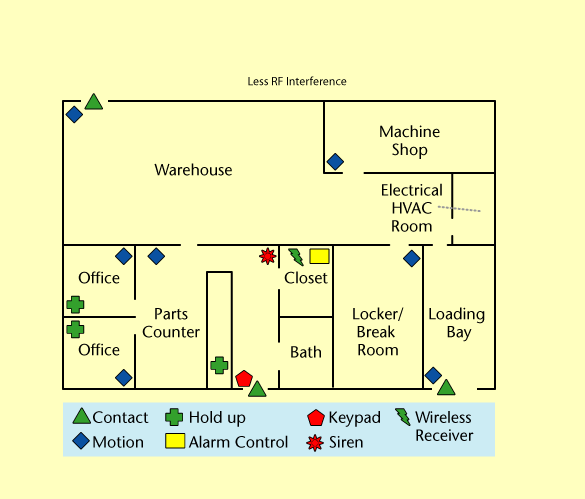1. Multiple transmitter signal paths can cause nulls.
a. True
b. False
2. Diverse (Dual) antennas are used on a receiver to:
a. extend range.
b. provide supervision.
c. reduce nulls.
d. All of the above
3. Which of the following frequencies are used for security wireless systems?
a. 300 MHz
b. 450 MHz
c. 900 MHz
d. All of the above
4. A fully supervised wireless system monitors the:
a. condition of the battery.
b. status of the device (door open/closed).
c. functionality of the transmitter.
d. All of the above
5. As the frequency increases, the wavelength decreases.
a. True
b. False
6. Which of the following construction materials will reflect RF signals?
a. Wood paneling
b. Sheetrock
c. Bulletproof glazing
d. Metal ducts
e. All of the above
7. Trees and vegetation have no effect on RF signals.
a. True
b. False
8. A burglar alarm control panel must be specifically designed to accommodate wireless devices.
a. True
b. False
9. Wireless transmitters can include a:
a. motion detector.
b. smoke detector.
c. glass break detector.
d. door/window contact.
e. All of the above
10. The orientation of the receiver’s antenna is not important.
a. True
b. False
11. Which of the following can affect the usable life of the battery in a wireless transmitter?
a. Environment
b. Usage
c. Device type
d. All of the above
12. All wireless systems are fully supervised.
a. True
b. False
13. Wireless devices are designed only for indoor use.
a. True
b. False
14. Signal strength is the only factor to consider when determining the reliability of a transmitter.
a. True
b. False
15. Wireless systems can provide:
a. tracking and location.
b. man-down alerts.
c. a virtual fence.
d. Any of the above

What’s Wrong with This?
Wally `Larman installed a wireless system for an auto parts store. He installed the devices as shown in this diagram and tested all transmitters. A few days later, his customer called and told Wally that frequently the keypad would display trouble for some of the transmitters. Can you see what Wally did wrong and what he must do to correct the problem?Here are the answers to the 5-Minute Tech Quiz and What's Wrong with This?
1. a2. c
3. d
4. d – Each of these should be monitored for maximum supervision. Not all wireless systems monitor the status of the door/window, but this is important information when a user is arming the system.
5. a – As the frequency increases, the wavelength does decrease. For example, the wavelength of 300 MHz is approximately 20 feet while the wavelength for 900 MHz is approximately 1 foot.
6. d
7. b – Trees and vegetation will absorb some of the energy and reduce range.
8. b – Although some controls are specifically designed to accommodate wireless devices, it is possible to add fully supervised wireless devices to any hard-wired panel.
9. e – In addition to these types of transmitters, heat, manual fire, panic and universal transmitters also are available.
10. b
11. d
12. b – Some systems monitor only the battery condition while others do not monitor any functions at all.
13. b
14. b – The background RF “noise level†also is an important consideration, because a high level of RF noise can overpower the security transmitters.
15. d

Answer to: What’s Wrong with This?
Wally’s problem is caused by where he located the wireless receiver. Electric and HVAC rooms typically contain large metal ducts, enclosures and generally have a high level of RF noise from the motors and electric panels. Additionally, the machine shop is located in an adjacent room, which also will generate large amounts of RF interference. Wally should relocate the receiver to the closet as shown in this diagram and retest the system.It always is a good idea when installing a wireless system to locate the receiver near the center of all transmitters to provide the best coverage. As with all security systems, you should evaluate carefully the area to be protected to uncover any possible sources of interference and locate the equipment accordingly.